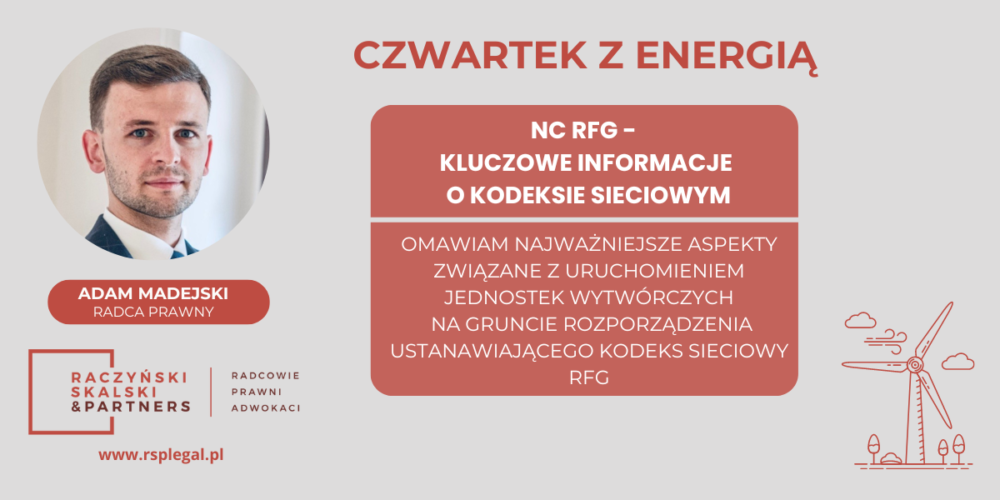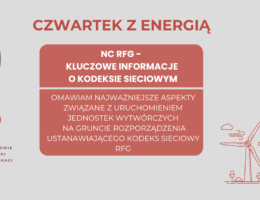Electricity generators will certainly become aware of the existence of the Network Code Requirements for Connection of Generating Units to the Grid (NC RfG – Network Code Requirements for Generation) at the stage of applying for connection conditions and concluding a connection agreement. Ensuring the compliance of a given generating unit with the technical requirements for connection to the grid includes not only the issues defined by the electricity system operator, but also the universal obligations described in the European Commission Regulation 2016/631 adopted on April 14, 2016.
1. What is the grid code?
The RfG Network Code is a European Commission regulation that was issued in connection with the ongoing integration of the electricity market within the European Union, with the aim of creating a common market. Behind this idea is the need to unify and standardize the technical requirements that are placed on generating units in member countries. In order to guarantee the compatibility of cross-border connections, it is also necessary to ensure that generating units are built and connected to the grid according to the same standards.
Since the NC RfG is an EU regulation it applies directly, not through implementation. This means that both the ERO President and power grid operators are directly bound by the provisions of the code and resolve compliance issues by the generating units concerned based on its provisions.
The provisions of the NC RfG are directly referred to in the instructions for the operation and use of power grids – suffice it to say that one of the mandatory requirements before entering into a distribution service agreement is to obtain final operating permits, in the cases indicated in the NC RfG. Thus, this is an example of direct application of the provisions of the Network Code in practice.
2. NC RfG – key issues
In a nutshell, ensuring technical compliance of a generating unit with the requirements of the NC RfG is a prerequisite for the proper operation of that unit. In basic terms, the provisions of the Grid Code introduce four categories of generating units (named in the Code as power generation modules), and further technical requirements for these units depend on the categorization. The higher the category, the higher the requirements to be met.
The division of power generation modules is as follows:
a) Type A power generation module – a power generation module connected to a grid with a voltage lower than 110 kV and a maximum power of not less than 0.8 kW and less than 200 kW,
b) Type B energy generation module – an energy generation module connected to a grid with a voltage of less than 110 kV and a maximum power of not less than 200 kW and less than 10 MW,
c) Type C power generation module – a power generation module connected to a grid with a voltage of less than 110 kV and a maximum power of not less than 10 MW and less than 75 MW,
d) Type D energy generation module – an energy generation module connected to a grid with a voltage lower than 110 kV.
It is worth knowing that according to Article 7(3) of the Regulation, the provisions of the Grid Code should be applied in a transparent, non-discriminatory and proportionate manner.
The most important obligation of the generator, as described in Article 29 et seq. of the Grid Code, is to demonstrate to the electricity system operator that the generating unit in question has the appropriate operating permits, in accordance with the requirements indicated in the NC RfG. Depending on the category of the unit, these requirements are different – the higher the unit’s capacity, the higher the requirements.
The least formalized requirements are for Category A units. According to Article 30 of the Grid Code, the generator should submit to the distribution system operator the information contained in the installation document. The model of such a document is determined by the DSO. Meeting this requirement conditions the lawful connection of the unit to the grid.
Units in categories B and C, in accordance with Articles 31 and 32 of the Code, must have a so-called PGMD issued, i.e. a certification of compliance that the unit meets the requirements of the Code. The detailed content of such a document should be in accordance with the list indicated in Article 32(2) of the NC RfG, and its presentation to the electricity system operator is necessary, among other things, for the conclusion of a perpetual distribution service contract.
With regard to Category D units, the RfG Code uses three important abbreviations that are quite common in the circulation of energy law regulations: ION, EON and FON.
According to Article 33 of the NC RfG, they mean, in turn:
(a) voltage application permit (,,EON”);
(b) temporary operating permit (,,ION”); and
(c) final operating permit (,,FON”).
An FON permit (Article 36 of the NC RfG) is required for commissioning the unit and ensuring its proper operation with the power grid.
There is also a distinction between the so-called LON permit, which is issued when, as a result of a major modification or failure, a category D unit for which a FON permit has been issued fails to comply for at least 3 months (Article 37 (1) and (2) NC RfG). The granting of a LON permit is conditional and temporary.
3.Generator’s perspective
From the generator’s perspective, issues related to the NC RfG need to be addressed at multiple stages:
-
-
- preparatory stage – what group will the generating unit be classified in and what costs may be involved in bringing it into compliance with the requirements set forth in the NC RfG?
- design stage – if the design or construction of the plant is outsourced to a third party, care should be taken to ensure that the contractual scope of this contractor’s responsibilities includes ensuring compliance with NC RfG regulations and requirements
- the grid connection stage – the correctness of the installation is subject to assessment by the electricity system operator, who, with regard to compliance with the NC RfG, should approve the unit’s compliance with the requirements of the code.
- stage of commercial operation – regardless of compliance with NC RfG requirements, the generator should continuously monitor primarily the obligations indicated in the instructions for network operation and maintenance. Their updates may impose new technical requirements, which in the long run may become a necessary standard to be implemented.
-
The provisions of the NC RfG provide for the possibility for a generator to apply for a consent to deviate from meeting the requirements of the Grid Code (Article 60 of the NC RfG), but such a consent is issued in specific cases, and according to the list made available by the President of the ERO, so far – as of 2016. – only 3 such consents have been issued, and each of them, according to the regulations, was temporary in nature. As a result, in order to ensure the smooth operation of a generating unit, the first thing to do is to ensure that its technical parameters comply with the provisions of the NC RfG.



